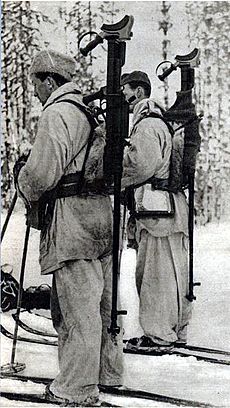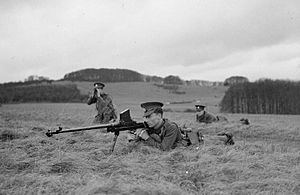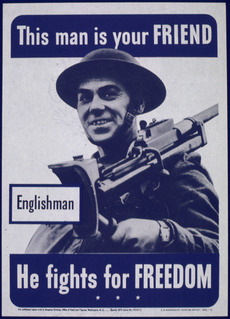Boys anti-tank rifle facts for kids
Quick facts for kids Boys anti-tank rifle |
|
|---|---|
| Type | Anti-tank rifle |
| Place of origin | United Kingdom |
| Service history | |
| In service | 1937–1998 |
| Used by | See Who used the Boys rifle? |
| Wars |
|
| Production history | |
| Designed | 1937 |
| Manufacturer | Royal Small Arms Factory |
| Produced | 1937–1940 |
| No. built | ~62,000 |
| Variants | Mk I, Mk I*, Mk II |
| Specifications | |
| Mass | 35 lb (16 kg) unloaded |
| Length | 5 ft 2 in (1.57 m) |
| Barrel length | 36 in. (910 mm); Airborne: 30 in. (762 mm) |
|
|
|
| Cartridge | .55 Boys (Kynoch & RG) |
| Calibre | 0.55 in (14 mm) |
| Action | Bolt-action rifle |
| Rate of fire | ~10 round/min |
| Muzzle velocity | Mk I: 747 m/s (2,450 ft/s) Mk II: 884 m/s (2,900 ft/s) |
| Effective firing range | 100 yards (91 m): 23.2mm penetration at 90° 500 yards (460 m): 18.8mm penetration at 90° |
| Feed system | 5-round detachable box magazine |

The Boys anti-tank rifle was a special type of rifle used by the British during World War II. Its official name was Rifle, Anti-Tank, .55in, Boys. Soldiers often called it the "elephant gun" because it was very large and had a big 0.55 in (14 mm) barrel.
There were three main versions of the Boys rifle. The early model (Mark I) had a round muzzle brake and a T-shaped stand called a monopod. It was mostly built in England. A later model (Mk I*) had a rectangular muzzle brake and a V-shaped stand called a bipod. This one was mainly made in Canada. There was also a third version made for soldiers who jumped out of planes (airborne forces). This version had a shorter barrel and no muzzle brake. Different types of bullets were also made, with newer ones being able to go through armor better.
At the start of the war, the Boys rifle was good enough to stop light tanks. But as tanks got stronger armor, the Boys rifle became less effective. It was later replaced by a different weapon called the PIAT in the middle of the war.
Contents
How was the Boys rifle designed?
This powerful rifle was created by Captain Henry C. Boys. He was a designer at the Royal Small Arms Factory in England. The rifle was first called Stanchion. But it was renamed after Captain Boys when he sadly passed away in November 1937, just before the rifle was approved for use.
Features of the rifle
The Boys rifle worked like a bolt action rifle. It held five bullets in a magazine. The weapon was quite big and heavy. It had a bipod (a two-legged stand) at the front and a special grip under the padded butt (the part that rests against your shoulder).
To help with the strong kickback (recoil) from firing such a large bullet, the rifle had a special device called a muzzle brake on the barrel. The main part of the rifle could also slide back and forth on its frame. This movement was softened by a shock absorber at the back. The rifle was known for being hard to fix because it had many tiny screws that were very tight.
The special bullets it used
The .55 Boys bullet was a modified version of another large bullet, the .50 BMG. It had a special "belt" around it. When the rifle was first introduced, its bullets could go through armor about 23.2 mm (0.91 in) thick from 100 yards (91 m) away.
Two main types of bullets were used during World War II. The W Mark 1 bullet weighed 60 g (930 gr) and traveled at 747 m/s (2,450 ft/s). It could pierce 0.91 in (23.2 mm) of armor at 100 yards (91 m). This was enough for the front armor of some small vehicles or the sides of light tanks. Later, a more powerful bullet called the W Mark 2 was developed. It had a tungsten core and flew even faster, at 945 m/s (3,100 ft/s).
Even with its special recoil system, firing the Boys rifle was painful. It caused a lot of noise and a big flash from the muzzle. Soldiers often got neck strains and bruised shoulders. Because of this, the rifle was almost always fired while resting on a support, not held freely.
How was the Boys rifle used in battles?
The Boys rifle was used early in World War II against German tanks that had lighter armor. Britain also sent many Boys rifles to Finland in 1939 and 1940. This was during the Winter War against the Soviet Union. Finnish soldiers liked the weapon because it could stop Soviet T-26 tanks.
Effectiveness in different campaigns
The Boys rifle was useful against early German and Italian tanks in places like France and North Africa. These included tanks like the Panzer I and Panzer II. However, as the war continued, tanks got much thicker armor. This made the Boys rifle largely ineffective against them.
A shorter version of the rifle was made in 1942 for airborne forces. It was used in Tunisia but didn't work well because the shorter barrel made the bullets slower. The Boys rifle was also quite heavy and hard to carry around.
Its reputation and replacement
After the Battle of France, the Boys rifle got a bad reputation. The Canadian government even asked Walt Disney Studios to make a training film called Stop That Tank! (1942). This film aimed to improve the rifle's image.
However, in Europe, the Boys rifle was soon replaced by the PIAT (Projector, Infantry, Anti-Tank) in 1943. The PIAT was first used during the Allied invasion of Sicily. The Boys rifle was still used a bit against bunkers, machine gun nests, and lightly armored vehicles. But it was quickly replaced by the American M2 Browning machine gun in British and Commonwealth armies.
The .50 Browning machine gun used different types of armor-piercing bullets. It was just as good at piercing armor and could cause more damage to thin-skinned vehicles. It could also be used to shoot down aircraft. However, the Browning was much heavier, weighing 38 kg (84 lb) without its stand. Even the British Special Air Service, who often used captured weapons, quickly swapped their Boys rifles for M2 Brownings.
Use in the Pacific and beyond
The Boys rifle was a standard weapon for British and Commonwealth forces fighting the Japanese in the Pacific War. However, it was not very effective. For example, at Milne Bay, it failed to stop Japanese tanks. Some reports say that one regiment did manage to knock out two light Japanese tanks in Malaya. During the Battle of Singapore, the Boys rifle was useful for making holes in walls during street fighting. After the war, the gun was used by the Royal Malay Regiment against communist fighters in the Malayan Emergency.
The U.S. Marine Corps bought Boys rifles from Canada before the attack on Pearl Harbor. They used them in a limited way against enemy bunkers. The U.S. Army's 1st Ranger Battalion also had Boys rifles, but they didn't use them in combat.
The Boys rifle was also used by the Chinese Nationalist Army during the Second Sino-Japanese War. It was also used by the Philippine Army during World War II against the Japanese. After the war, it was used against communist fighters in the Hukbalahap Rebellion and by Philippine forces in the Korean War.
In 1965, members of the IRA used a Boys rifle to damage a British patrol boat, HMS Brave Borderer, while it was visiting Waterford, Ireland.
How well did the Boys rifle perform?
Training manuals for the Boys rifle said it was meant to protect soldiers from light armored vehicles. It could pierce their armor up to about 500 yards (460 m) away. It could also injure the crew inside, even if it didn't completely destroy the vehicle.
A manual for the Home Guard in 1944 showed how well it performed. It could go through about 22.3 mm (0.88 in) of armor at 100 yards (91 m) if hitting straight on. At 500 yards (460 m), hitting at an angle, it could still go through about 8.8 mm (0.35 in) of armor. The manual also noted it could penetrate 14 in (360 mm) of brick walls or 10 in (250 mm) of sandbags.
Who used the Boys rifle?
Many countries and groups used the Boys anti-tank rifle:
 Australia
Australia British India
British India Canada: Canada produced 771 Boys Rifles, selling them to the United States.
Canada: Canada produced 771 Boys Rifles, selling them to the United States. China
China Finland – known as 14 mm pst kiv/37, used during the Winter War and Continuation War.
Finland – known as 14 mm pst kiv/37, used during the Winter War and Continuation War. France – received many rifles in exchange for other anti-tank guns.
France – received many rifles in exchange for other anti-tank guns. Ireland
Ireland- Provisonal IRA used it during The Troubles.
 Israel
Israel Kingdom of Italy – captured some during the North African campaign.
Kingdom of Italy – captured some during the North African campaign. Malaya
Malaya Nazi Germany – captured rifles from British forces were called 13,9 mm Panzerabwehrbüchse 782 (englisch).
Nazi Germany – captured rifles from British forces were called 13,9 mm Panzerabwehrbüchse 782 (englisch). New Zealand
New Zealand Philippines
Philippines Poland: Polish Armed Forces in the West
Poland: Polish Armed Forces in the West Portugal
Portugal Soviet Union – received 3,200 Boys rifles through a program called Lend-Lease.
Soviet Union – received 3,200 Boys rifles through a program called Lend-Lease. South Africa
South Africa United Kingdom
United Kingdom United States – used by Marine Raiders. Some were used experimentally as long-range sniper rifles during the Korean War.
United States – used by Marine Raiders. Some were used experimentally as long-range sniper rifles during the Korean War. Yugoslav Partisans
Yugoslav Partisans
Mounted on vehicles
The Boys Rifle was sometimes attached to vehicles. These included the Universal Carrier (also known as the "Bren Gun Carrier"), the Humber Light Reconnaissance Car, and armored cars like the Morris CS9, Standard Beaverette, and Rolls-Royce.
See also
- Mauser 1918 T-Gewehr
- PTRD-41
- PTRS-41
- Wz. 35 anti-tank rifle



